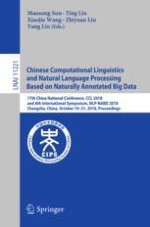2018 | Buch
Chinese Computational Linguistics and Natural Language Processing Based on Naturally Annotated Big Data
17th China National Conference, CCL 2018, and 6th International Symposium, NLP-NABD 2018, Changsha, China, October 19–21, 2018, Proceedings
herausgegeben von: Maosong Sun, Ting Liu, Xiaojie Wang, Zhiyuan Liu, Yang Liu
Verlag: Springer International Publishing
Buchreihe : Lecture Notes in Computer Science
